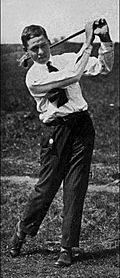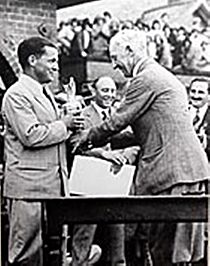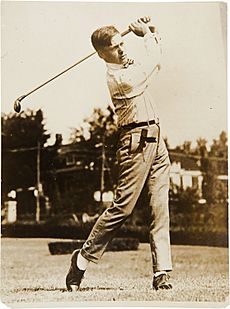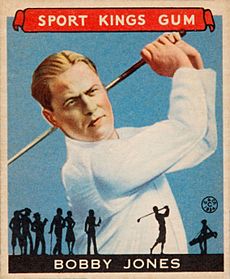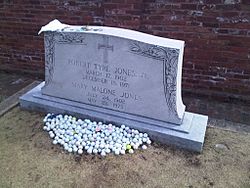Bobby Jones (golfer) facts for kids
Quick facts for kids Bobby Jones |
|
|---|---|
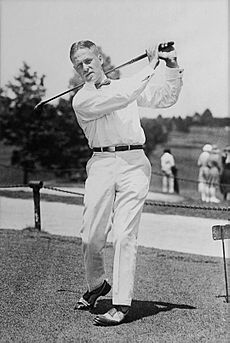
Jones, c. 1921
|
|
| Personal information | |
| Full name | Robert Tyre Jones Jr. |
| Born | March 17, 1902 Atlanta, Georgia, U.S. |
| Died | December 18, 1971 (aged 69) Atlanta, Georgia, U.S. |
| Height | 5 ft 8 in (1.73 m) |
| Weight | 165 lb (75 kg; 11.8 st) |
| Nationality | |
| Spouse | Mary Rice Malone Jones (1902) (m.1924–1971, his death) |
| Children | Clara Malone Jones Black Robert Tyre Jones III Mary Ellen Jones Hood |
| Career | |
| College | Georgia Tech Harvard University Emory University |
| Retired | 1930 |
| Professional wins | 9 |
| Number of wins by tour | |
| PGA Tour | 9 |
| Best results in Major Championships (Wins: 13) |
|
| The Masters Tournament | T13: 1934 |
| U.S. Open | Won: 1923, 1926, 1929, 1930 |
| The Open Championship | Won: 1926, 1927, 1930 |
| PGA Championship | DNP |
| U.S. Amateur | Won: 1924, 1925, 1927, 1928, 1930 |
| British Amateur | Won: 1930 |
| Achievements and awards | |
| World Golf Hall of Fame | 1974 |
| James E. Sullivan Award | 1930 |
| Georgia Tech Athletic Hall of Fame |
1958 |
| Georgia Tech Engineering Hall of Fame |
1997 |
|
Bobby Jones
|
|
|---|---|
| Allegiance | |
| Service/ |
|
| Rank | |
| Unit | Intelligence |
| Battles/wars | World War II, European theater |
Robert Tyre Jones Jr. (born March 17, 1902 – died December 18, 1971) was an amazing American amateur golfer. He was one of the most important people in golf history. Besides being a golf legend, he was also a lawyer.
Bobby Jones helped create and design the famous Augusta National Golf Club. He also co-founded the Masters Tournament, which is now one of the biggest golf events in the world. Many of the new ideas he brought to the Masters are now used in almost every professional golf tournament.
Jones was the most successful amateur golfer ever to play at a high level. From 1923 to 1930, he was the best amateur and often beat top professional golfers like Walter Hagen and Gene Sarazen. Even though he was a lawyer by trade, he played golf just for fun, not for money. He decided to stop competing at age 28. He later earned money from golf by teaching and designing equipment.
When asked why he retired so young, Jones said that championship golf was like a cage. He felt that once you got to the top, everyone expected you to stay there, which he knew was impossible. Jones is most famous for his unique "Grand Slam" in 1930. This meant he won all four major golf tournaments of his time in one year. In total, Jones played in 31 major tournaments, winning 13 of them and finishing in the top ten 27 times.
After retiring from competitive golf in 1930, Jones helped create the Augusta National Golf Club in 1933. He also co-founded the Masters Tournament, which has been held there every year since 1934 (except during World War II). The Masters became one of golf's four major championships. Jones even played in the Masters as an exhibition player from 1934 to 1948. He played his last round of golf at his home course, East Lake Golf Club in Atlanta, on August 18, 1948. He stopped playing golf permanently due to health reasons.
People sometimes confused Bobby Jones with another famous golf course designer, Robert Trent Jones. To avoid mix-ups, the golfer was called "Bobby," and the designer was called "Trent."
Contents
Biography
Early Life and Golf Beginnings
Bobby Jones was born in Atlanta, Georgia. When he was a young boy, he had some health problems. Doctors suggested golf to help him get stronger. His father, "Colonel" Robert Purmedus Jones, who was also a lawyer, encouraged him. Bobby loved golf right away and quickly became a child golf star. He won his first children's tournament at age six at his home course, East Lake Golf Club.
In 1916, at just 14 years old, Jones won his first big golf event: the Georgia Amateur Championship. This win made people across the country notice him. The United States Golf Association invited him to play in the U.S. Amateur near Philadelphia. In his first time playing, Jones made it to the quarterfinals.
He learned a lot from his club professional, Stewart Maiden, who was from Scotland. Maiden also coached Alexa Stirling, another golf star from East Lake. Jones also got lessons from Willie Ogg. He often played with his father, who was a good golfer too. Early on, Jones sometimes got angry on the course, but he learned to control his emotions as he got more experienced. During World War I (1917–18), Jones traveled around the U.S. playing exhibition matches with Alexa Stirling to raise money for war relief. Playing in front of big crowds helped him prepare for national competitions.
Jones first played for the United States in international amateur team matches against Canada in 1919 and 1920. He helped the U.S. win both times. In 1919, he played in the Canadian Open and finished tied for second. Another golfer, J. Douglas Edgar, who moved to Atlanta in 1919, played often with Jones and helped him improve his game a lot.
Jones played in his first U.S. Open in 1920 at age 18. He was paired with the legendary golfer Harry Vardon for the first two rounds. He also won the Southern Amateur three times: in 1917, 1920, and 1922.
Winning Major Championships
As an adult, Bobby Jones became incredibly good at golf. He won his first U.S. Open in 1923. From that win until his victory in the U.S. Amateur in 1930, he won 13 major championships out of 20 attempts. He was the first player to win "The Double," meaning both the U.S. Open and British Open Championships in the same year (1926). He was also the second (and last) to win both the U.S. Open and U.S. Amateur in the same year (1930).
The Amazing 1930 Grand Slam
Bobby Jones is the only golfer ever to win the "Grand Slam" in a single year (1930). This means he won all four major championships of his time. Here's how he did it:
- The Amateur Championship in Scotland (May 31, 1930)
- The Open Championship in England (June 20, 1930)
- U.S. Open in Minnesota (July 12, 1930)
- U.S. Amateur in Pennsylvania (September 27, 1930)
Before the first tournament, Jones even made a bet with British bookmakers that he would achieve this amazing feat. He got odds of 50 to 1 and won over $60,000 when he did it!
Jones also played for the United States in the Walker Cup five times. He won nine out of his ten matches, and the U.S. team won the trophy all five times. He was the playing captain for the U.S. team in 1928 and 1930. He also won two other tournaments against professionals: the 1927 Southern Open and the 1930 Southeastern Open. Jones was a lifelong member of the Atlanta Athletic Club and the Capital City Club in Atlanta.
Bobby Jones is considered one of the five biggest sports stars of the 1920s in America. The others were Babe Ruth (baseball), Jack Dempsey (boxing), Red Grange (football), and Bill Tilden (tennis). He was the first person to receive the James E. Sullivan Award as the top amateur athlete in the United States. He is also the only sports figure to have two ticker-tape parades in New York City, one in 1926 and another in 1930. In Augusta, Georgia, there's a highway called the Bobby Jones Expressway named after him.
Great Sportsmanship
Bobby Jones was not just a super skilled golfer; he was also a great example of sportsmanship and fair play. In the first round of the 1925 U.S. Open, his ball landed in thick grass near the green. As he got ready to hit, his club accidentally brushed the grass, and the ball moved a tiny bit. Even though no one else saw it, he told his playing partner, Walter Hagen, and the official that he was taking a penalty on himself.
Hagen tried to talk him out of it, but Jones insisted. After the round, officials also argued with him, but he stuck to his decision, saying he had broken a rule. This one-stroke penalty meant he lost the tournament by one stroke, leading to a playoff which he then lost. Many sports writers praised him, but Jones famously said, "You might as well praise me for not robbing banks." He meant that following the rules was just what you're supposed to do.
Something similar happened in the next U.S. Open in 1926. While putting, his ball rolled a tiny bit because of the wind. Again, no one else noticed, but Jones called a penalty on himself. This time, he still went on to win the tournament, which was his second U.S. Open victory.
The USGA's award for sportsmanship is called the Bob Jones Award in his honor.
Special Connection with St Andrews, Scotland
Bobby Jones had a unique relationship with the town of St Andrews, Scotland. The first time he played on the Old Course at St Andrews in the 1921 Open Championship, he was so frustrated that he quit during the third round. He even tore up his scorecard and said he didn't like the course. The town's newspapers even called him "just a boy."
But later, he grew to love the Old Course and the town very much. When he won the Open there in 1927, he surprised everyone by asking that the trophy stay with his friends at the The Royal and Ancient Golf Club of St Andrews instead of going back to Atlanta with him. In 1930, he won the British Amateur at the Old Course. He even made a "double eagle" (a score of 2 on a par-5 hole) by sinking a very long shot from a sand bunker.
In 1958, he was given the "Freedom of the City" honor in St Andrews. He was only the second American to receive this, after Benjamin Franklin in 1759. As Jones left the ceremony, the crowd spontaneously sang "Will Ye No Come Back Again?" to him, which was a very touching moment. Today, there's a special scholarship exchange program named after Jones between the University of St Andrews and several universities in the U.S. and Canada, including Emory University and Georgia Institute of Technology.
University, Family, and Career
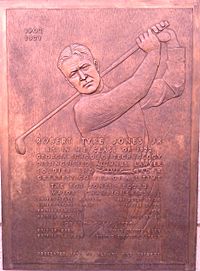
Bobby Jones was also very successful outside of golf. He earned a degree in Mechanical Engineering from Georgia Tech in 1922, where he played on the golf team for four years. He was part of the Sigma Alpha Epsilon fraternity, and their house at Georgia Tech is named after him.
He then earned a degree in English Literature from Harvard College in 1924. In 1926, he started studying law at Emory University School of Law. After only three semesters, he passed the Georgia bar exam and joined his father's law firm in Atlanta.
Jones married Mary Rice Malone in 1924, and they had three children. When he retired from golf at age 28, he focused on his law practice in Atlanta. In 1930, he received the first James E. Sullivan Award for being the best amateur athlete in the United States.
Golf Films and Club Design
Between 1931 and 1933, Jones made 18 instructional golf films in Hollywood. In these films, he coached famous movie stars and gave golf tips. The films were very popular, and Jones earned a lot of money from them, which meant he was no longer an amateur golfer. These films were stored away for decades, but a copy was found 60 years later and saved.
In the early 1930s, Jones also worked with J Victor East of A.G. Spalding & Co. to create the first set of matched golf clubs with steel shafts. These clubs sold very well and are still considered some of the best-designed sets ever made.
Founding Augusta National Golf Club
After retiring from competitive golf in 1930, Bobby Jones was one of the most famous sports figures in the world. He was recognized almost everywhere he went. While he appreciated the attention, he wanted a private golf club where he and his friends could play in peace. For several years, he looked for land near Atlanta to build his own club.
His friend Clifford Roberts, an investment dealer, knew about Jones's wish. He found a promising property for sale in Augusta, Georgia, where Jones's mother-in-law had grown up. Jones visited the land, which was an old plantation, in 1930. He bought it for $70,000 in 1931, planning to design a golf course there.
Jones co-designed the Augusta National course with Alister MacKenzie. The new club opened in early 1933. He then founded the Masters Tournament, which was first played at Augusta in March 1934. The tournament, originally called the Augusta National Invitational, was an instant success and attracted most of the world's top players. Jones came out of retirement to play in it as an exhibition, and his presence brought a lot of media attention, making the new tournament even more famous.
During World War II, Jones served as an officer in the U.S. Army Air Forces. He wanted to serve overseas, even though his superiors wanted him to play exhibition golf in the U.S. In 1943, he was promoted to major and trained as an intelligence officer. He served in England and landed in Normandy on June 7, 1944. He spent two months on the front lines, reaching the rank of lieutenant colonel. During the war, Jones allowed the U.S. Army to graze cattle on the grounds at Augusta National. Later, in 1947, he founded Peachtree Golf Club in Atlanta and co-designed the course with Robert Trent Jones.
In 1966, the leaders of Augusta National made Jones "President in Perpetuity," meaning he would be president forever.
Later Years and Health Challenges
Bobby Jones played in the first twelve Masters tournaments, until 1948. However, he only competed in the very first one. By 1948, at age 46, his health had declined, making it impossible to compete seriously. He never truly challenged for the Masters title, but his scores were still good. His main role was as the host of the event. His huge popularity and his work on the course design and tournament organization greatly boosted the Masters' fame.
The Masters, run by Jones and Clifford Roberts, introduced many new ideas that became standard in other tournaments. These included ropes to control crowds, many scoreboards around the course, using red and green numbers on scoreboards to show scores under or over par, inviting top players from around the world, high-quality television coverage, and week-long admission passes. The tournament also asked for feedback from players, fans, and writers, which helped it get better and better over the years. The Masters slowly became one of the most respected tournaments in the world and one of the four major championships.
In 1948, Jones was diagnosed with syringomyelia, a serious spinal cord condition that caused pain and eventually paralysis. He ended up needing a wheelchair. Bobby Jones passed away in Atlanta on December 18, 1971. He was buried in Atlanta's historic Oakland Cemetery. Jones was honored by being inducted into the World Golf Hall of Fame in 1974.
His wife, Mary, passed away less than four years later in 1975.
Images for kids
-
Plaque at Georgia Tech honoring Jones
See also
 In Spanish: Bobby Jones (golfista) para niños
In Spanish: Bobby Jones (golfista) para niños


